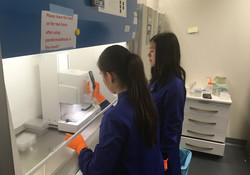WHO collaborating centre strengthens laboratory capacity of national influenza centres in the WHO European Region

WHO
Virologists from national influenza centres (NICs) in Warsaw (Poland), Bucharest (Romania), St Petersburg (Russian Federation) and Geneva (Switzerland) attended customized training courses at the WHO Collaborating Centre for Reference and Research on Influenza at the Francis Crick Institute in London, United Kingdom.
NICs play a critical role in influenza surveillance. They collect virus specimens in their countries, perform preliminary analysis and ship representative clinical specimens and isolated viruses to WHO collaborating centres for advanced antigenic and genetic analysis. The results form the basis of WHO recommendations on the composition of influenza vaccines each year and for WHO’s influenza risk assessments.
The 1–2-week courses were tailored to the specific needs of these NICs, and covered different aspects of laboratory diagnosis and virological surveillance of influenza. They aimed to equip participants with the skills to perform detection and characterization of circulating human seasonal influenza viruses.
The participants, 2 from each of the NICs, appraised the trainings very positively and expressed their eagerness to apply relevant procedures that will enhance their NICs’ capacity for influenza virus characterization.
Ana Rita Gonçalves Cabecinhas and Patricia Suter-Boquete from the NIC in Geneva stated: “It was an enriching experience to do the training concomitantly with another NIC, as we had the opportunity to share about influenza surveillance and the associated strategies of our respective countries.” They emphasized that “this kind of interaction helps to strengthen collaboration between different centres”.
“We were four persons performing the assay at the same time and we really enjoyed it,” they continued. “The group was small enough to give everyone the opportunity to actively participate.”
NIC in Warsaw
Training for the NIC in Warsaw focused on techniques of influenza virus isolation in cell culture and the identification of the haemagglutinin subtype of viral isolates by haemagglutination inhibition (HAI) testing. Additionally, participants received training on virological assays used to identify the susceptibility of influenza viruses to drugs.
NICs in Geneva and Bucharest
Training for the NICs in Geneva and Bucharest focused on influenza virus microneutralization assay (plaque reduction assay), which is used as an alternative to HAI testing to study the antigenic properties and infectivity of influenza viruses. Microneutralization assays can overcome non-antigenic effects influenced by the affinity changes of receptor binding in influenza viruses, which can complicate the interpretation of HAI results.
NIC in St Petersburg
Training for the NIC in St Petersburg focused on next generation sequencing (NGS) techniques used to perform whole-genome characterization of influenza viruses. The participants received training on laboratory procedures used to prepare NGS libraries and in methods to establish a cost-effective sequencing protocol. They also familiarized themselves with the advantages and disadvantages of various software packages used to analyse NGS data.
Background
The WHO Collaborating Centre at the Francis Crick Institute regularly provides training for virologists from NICs around the world. It tailors each training course to the specific needs of the trainees, and covers all laboratory costs.
This training was funded both by the Pandemic Influenza Preparedness Framework Partnership Contribution Implementation Plan 2013–2016, which aims to strengthen capacity and influenza virological surveillance in NICs in the WHO European Region, and by WHO/Europe’s programme on high-threat pathogens as part of its annual training programme for influenza virologists.



